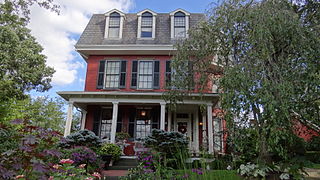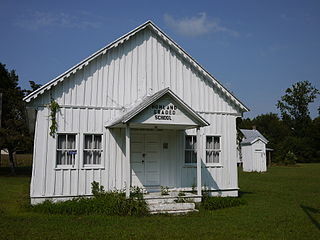
West Virginia Independence Hall is a historic government building at 1528 Market Street in downtown Wheeling, West Virginia, United States. It was built in 1860 under the supervision of architect Ammi B. Young for the federal government as a custom house, post office and courthouse. It is architecturally significant for its innovative uses of wrought iron as a framing material, and is historically significant for its role in the American Civil War. It housed the Wheeling Convention (1861), as well as the West Virginia Constitutional Convention (1863), which resulted in the separation of Unionist West Virginia from Confederate Virginia. This made it the only state to secede from a Confederate state during the war. The building was originally built as the custom house for the Western District of Virginia, and later became the center of government for the Restored Government of Virginia from 1861 to 1863, with Francis H. Pierpont serving as its governor. It was declared a National Historic Landmark in 1988. The building is now a state-run museum, housing exhibits on West Virginia history.

The Thomas Select School is a historic log building in rural Butler County, Ohio, United States. Constructed in 1810, the building has seen numerous uses, ranging from church to school to house. It has been named a historic site.

The Alexander Wade House is a historic house at 256 Prairie Street in Morgantown, West Virginia. Built in 1860, it was the home of educator Alexander Wade (1832-1904) from 1872 until his death. Wade is credited with developing a system of grade promotional exams and graduations that was widely adopted in the late 19th century. The house was declared a U.S. National Historic Landmark in 1965.

The Virginia Randolph Cottage, now the Virginia E. Randolph Museum is a museum at 2200 Mountain Road in Glen Allen, Virginia. The museum is dedicated to the history of Virginia E. Randolph (1874–1958), an African-American vocational educator in the area for 55 years. The building, built in 1937 and housing Randolph's home economics classrooms, is a National Historic Landmark in recognition of her legacy as a trainer of vocational teachers, and her remains are interred on the grounds. It was declared a National Historic Landmark in 1974.

The Pearl Street School is a historic school building at 75 Pearl Street in Reading, Massachusetts. Built in 1939, the two-story brick and limestone building is Reading's only structure built as part of a Public Works Administration project. The site on which it was built was acquired by the town sometime before 1848, and served as its poor farm. With fifteen classrooms, the school replaced three smaller wood-frame schoolhouses in the town's school system, and was its first fire-resistant structure.

South Reading Academy is a historic former school building at 7 Foster Street in Wakefield, Massachusetts, US. Built in 1828–29 for the First Baptist Church, the building has served as a religious school, public high school, clubhouse, and commercial space. The building was listed on the National Register of Historic Places in 1989.

The Woodville School is a public elementary school at 30 Farm Road in Wakefield, Massachusetts. The present building was built in 2003, replacing an older building that was listed on the National Register of Historic Places in 1989.

The Great Falls Grange Hall and Forestville School are two historic buildings that served as a Grange meeting hall and as a school located in Great Falls, Fairfax County, Virginia. The Forestville School was built in 1889 as a one-room school, and expanded in 1911 with the appendage of the Floris School. It is an "L"-shaped wood-frame structure covered in weatherboards and topped by a standing-seam metal cross-gable roof. After closing as a school in 1922, it served as a residence and then as the Great Falls Post Office from 1959 until 1982. The Great Falls Grange Hall was built in 1929, and is a 1 1/2-story brick building with a gable front. It features a front porch supported by concrete pillars in the American Craftsman style. Both buildings are owned by the Fairfax County Park Authority.

Highland Park Public School is a historic school building located in Richmond, Virginia. The structure was built in 1909 based on a design by noted Virginia architect Charles M. Robinson. The Mediterranean Revival building is a two-story brick and stucco structure topped by hipped roofs clad with terra cotta tiles. In its use of the Mediterranean Revival style, the building was a departure from the Georgian and Gothic styles commonly used in Virginia school buildings of the time. The building used as the community school for Highland Park, Virginia, until the community was annexed by the City of Richmond in 1914. It served thereafter as a neighborhood school in the Richmond public school system until it closed in the 1970s. The building is considered to be important as an example of the work of Charles M. Robinson, who served as Richmond School Board architect from 1909 to 1930. The building was listed on the National Register of Historic Places in 1991. The building was converted from 1990 to 1991 into a residential apartment complex for senior citizens and re-opened under the name Brookland Park Plaza.

The Howland Chapel School is a historic school building for African-American students located near Heathsville, Northumberland County, Virginia. It was built in 1867, and is a one-story, gable fronted frame building measuring approximately 26 feet by 40 feet. It features board-and-batten siding and distinctive bargeboards with dentil soffits. The interior has a single room divided by a later central partition formed by sliding, removable doors. The building is a rare, little-altered Reconstruction-era schoolhouse built to serve the children of former slaves. Its construction was funded by New York educator, reformer and philanthropist Emily Howland (1827-1929), for whom the building is named. It was used as a schoolhouse until 1958, and serves as a museum, community center and adult-education facility.

The First Union School is a historic Rosenwald school building for African-American children located at 1522 Old Mill Rd. in Crozier, Goochland County, Virginia. It was built in 1926, as a "two-teacher" school. It is a one-story frame school on a concrete foundation. It has an engaged porch and hipped roof. The listing included two contributing buildings. The school operated until December 1958, when the county integrated its public schools. It was converted to residential use in 1985.

Barcroft Community House is a historic community center located at Arlington, Virginia. It was built in 1908, and is a one-story, American Craftsman style frame building. It initially served as a church building for the Methodist Episcopal Church. It housed the Barcroft School until a new school building opened in 1925. The building has served collectively as a church, school, and community meeting place since its construction.

Jericho School is a historic one-room school building located at Ruther Glen, Caroline County, Virginia.

Josephine City School is a historic school building for African-American children located at Berryville, Clarke County, Virginia. It was built about 1882, and is a rectangular, one-story, frame building with a gable roof and a four-bay side gable entrance facade. The school measures approximately 40 feet long and 30 feet wide. It is part of a school complex for African American children that included the Josephine City School; the 1930 brick Clarke County Training School; and a 1941 frame building that was constructed as additional agriculture classrooms. It was used as an elementary school until 1930, when it was moved a short distance from its original location, and used as the Clarke County Training School's home economics and agriculture classrooms. It was used for classrooms until 1971, when it was turned into storage space, after which it was converted into low/moderate-income elderly housing.

Ashwood School Gymnasium and Auditorium is a historic school gymnasium and auditorium located near Bishopville, Lee County, South Carolina. It was built in 1938 to serve Ashwood Plantation, the first and largest of the Resettlement Administration (RA) project tracts in South Carolina. The building served as the school and community gymnasium and as an auditorium for dramatic performances and films. It is a one-story building with a simplified Colonial Revival style popular in the 1930s in government-sponsored construction.

Ashwood is an unincorporated community in Maury County, Tennessee, in the United States.

Canton School is a historic one-room schoolhouse located in the unincorporated community of Canton, Iowa, United States. This school building was built in 1877 of locally quarried, roughly-dressed limestone, laid in a random ashlar pattern. The main facade, however, is faced with concrete brick that is original to the structure. What is unusual about this building is its decorative elements, as most one-room schoolhouses built in Iowa were plain. The eaves and the two-stage wooden bell tower are edged with rather delicate wooden trim, and the windows are capped with concrete keystone hoods. The use of concrete is rather sophisticated for a building in the vernacular-folk architectural style in stone. The building served as a school until 1966 when the area's school districts were reorganized. It served as a church until 1968, and it is now surrounded by a park.

The Elon Public Library is a historic public library building at Camden and Younger Drives in Amherst, Virginia. It is a modest vernacular single story wood frame structure with a gabled roof. It was built in 1918, and was the Amherst County's first rural free library. It served as a lending library for the surrounding area until 1965, as well as a community meeting space and polling place. It was closed when the county dedicated a portion of the nearby school for use as a public library.

The Spencer–Penn School is a historic school complex at 30 George Taylor Road in Spencer, Virginia. Its main building, a large brick Colonial Revival building, was built in 1926–27, and is the only surviving non-residential building in the community to be built before World War II. The campus also includes the school's first building, a frame structure built in 1911. The school served the area until 2004, when it was closed by the county school board. The campus is now home to the Spencer–Penn Centre, a non-profit education and special event center.

The Roland E. Cook Elementary School is a historic school building at 412 South Poplar Street in Vinton, Virginia. Built in 1915 as a T-shaped Classical Revival structure, it was expanded in 1924 to its present H shape, at which time it became Vinton High School. It served as a high school until 1933, when the William Byrd High School was built, and was then converted to an elementary school. It originally served the area's white population during the Jim Crow period of segregated facilities, and was integrated in 1966–67. It closed in 1999, and was mothballed after a period of use by an alternative school.
























